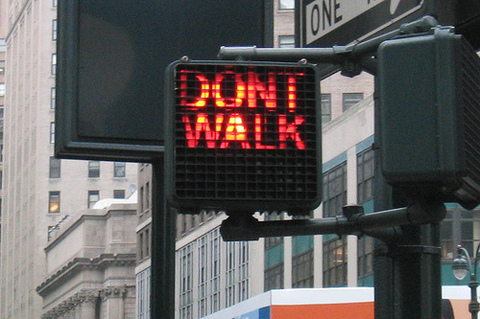Texas cities are not so safe for pedestrians. Yeah, I’m as shocked as you are.
Houston pedestrians better cross with care. The city is the seventh most dangerous in the nation for people on foot, according to a new report from the National Complete Streets Coalition at Smart Growth America, a nonprofit that advocates for neighborhood safety.
Texas ranked as the 10th most dangerous state for walking commuters, with nearly 4,200 pedestrian deaths between 2003 and 2012. That’s roughly 10 percent of such deaths nationally during that time period, according to data compiled from National Highway Traffic Safety Administration statistics.
Although the total number of traffic fatalities has decreased nationally, the number of pedestrian deaths has grown. In 2012, 15 percent of all traffic fatalities involved people on foot.
As Congress considers reauthorizing MAP-21, a 2012 law that funds national transportation infrastructure, nonprofits like Smart Growth America and their pro-public safety allies are urging lawmakers nationwide to pass additional federal policy that would ensure pedestrian safety.
“This is about making smarter choices, investing our transportation dollars in projects that help achieve multiple community goals, including public health and supporting local economies,” said Roger Millar, the director of the coalition.
Using numbers from the National Weather Service, the reports says the number of pedestrian deaths in the past decade — 47,000 — is 16 times higher than the number of people who died in natural disasters. But “pedestrian deaths don’t receive a corresponding level of urgency,” Millar added.
[…]
There are two key explanations for the danger of Houston streets, said Jay Blazek Crossley, a policy analyst at Houston Tomorrow, a nonprofit organization that examines urban issues in the region. One is the design of city streets, which he said prioritizes speed over safety. The other is that the region has chosen to spend on toll roads over safer urban design, he said.
“Our money is focused on building toll roads in the middle of nowhere,” Crossley said. “Instead of redesigning streets with safety in mind, we’re putting our attention there.”
Crossley added that Houston has made some recent strides. In October, Mayor Annise Parker announced an executive order establishing a citywide Complete Streets policy aimed at protecting pedestrians, motorists, bicyclists and public transit riders.
Dallas and San Antonio are also on the list, though not as high up as Houston. I don’t think there’s any question that the way our streets are built, to accommodate cars first and foremost, is the main reason behind this. As Wonkblog points out, cities that are safer for pedestrians tend to be older ones where the main street grid was built before cars existed, and thus were engineered for walking. The Complete Streets directive will help, but to say the least that’s a long-term fix. I don’t know what there is to do in the short run, but raising awareness can’t hurt. Ed Kilgore has more.


“There are two key explanations for the danger of Houston streets, said Jay Blazek Crossley, a policy analyst at Houston Tomorrow, a nonprofit organization that examines urban issues in the region. One is the design of city streets, which he said prioritizes speed over safety. The other is that the region has chosen to spend on toll roads over safer urban design, he said.”
“….prioritizes speed over safety.”
It’s hard enough to get around Houston as it its now, with traffic jams seemingly everywhere, at all hours, not just rush hour. So if anyone is suggesting that we need to slow traffic even more, um, yeah….no thanks.
It’s sad that we have so many pedestrians killed. However, I’m sure most of them would still be with us had they been more attentive. The saying, “you can be right, or you can be dead right” comes to mind. If you are considering asserting your rights against a 4,000+lb car or truck, maybe you deserve to get hit.
Some of those deaths no doubt come from impaired or inattentive drivers who leave the roadway and strike pedestrians off the roadway, and that is a tragedy, but I’m betting the majority were hit when they were in the roadway, and taking the time to make sure it was safe would have prevented most of those. That’s where individual responsibility comes in. Sure, there are areas that have no sidewalks, but with the limited resources available, I choose fixing the streets over building new sidewalks every time. The needs of the many, and all that.
We spend untold millions to make streets safer for drivers who are temporarily in attentive.
Do so for pedestrians is NOT out of the question.
It is interesting that Houston is top 10 of the danger index. Not top 10 in per capita deaths. The number of walkers is considerably lower here than elsewhere.
We spend untold millions to make streets safer for drivers who are temporarily in attentive.
Do so for pedestrians is NOT out of the question.
It is interesting that Houston is top 10 of the danger index. Not top 10 in per capita deaths. The number of walkers is considerably lower here than elsewhere.